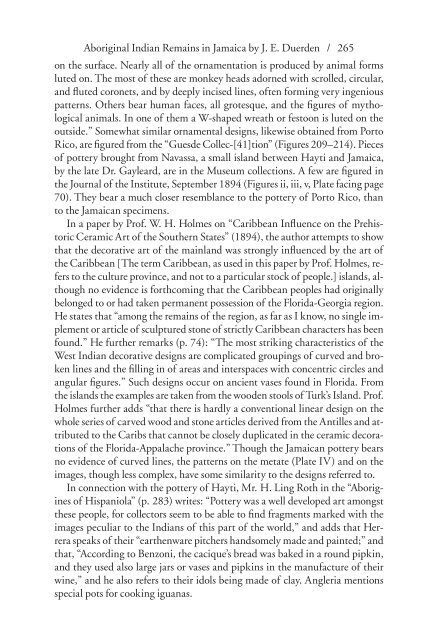Pre-Colombian Jamaica: Caribbean Archeology and Ethnohistory
by Phillip Allsworth-Jones
by Phillip Allsworth-Jones
Create successful ePaper yourself
Turn your PDF publications into a flip-book with our unique Google optimized e-Paper software.
Aboriginal Indian Remains in <strong>Jamaica</strong> by J. E. Duerden / 265<br />
on the surface. Nearly all of the ornamentation is produced by animal forms<br />
luted on. The most of these are monkey heads adorned with scrolled, circular,<br />
<strong>and</strong> fluted coronets, <strong>and</strong> by deeply incised lines, often forming very ingenious<br />
patterns. Others bear human faces, all grotesque, <strong>and</strong> the figures of mythological<br />
animals. In one of them a W- shaped wreath or festoon is luted on the<br />
outside.” Somewhat similar ornamental designs, likewise obtained from Porto<br />
Rico, are figured from the “Guesde Collec-[41]tion” (Figures 209–214). Pieces<br />
of pottery brought from Navassa, a small isl<strong>and</strong> between Hayti <strong>and</strong> <strong>Jamaica</strong>,<br />
by the late Dr. Gayleard, are in the Museum collections. A few are figured in<br />
the Journal of the Institute, September 1894 (Figures ii, iii, v, Plate facing page<br />
70). They bear a much closer resemblance to the pottery of Porto Rico, than<br />
to the <strong>Jamaica</strong>n specimens.<br />
In a paper by Prof. W. H. Holmes on “<strong>Caribbean</strong> Infl uence on the <strong>Pre</strong>historic<br />
Ceramic Art of the Southern States” (1894), the author attempts to show<br />
that the decorative art of the mainl<strong>and</strong> was strongly influenced by the art of<br />
the <strong>Caribbean</strong> [The term <strong>Caribbean</strong>, as used in this paper by Prof. Holmes, refers<br />
to the culture province, <strong>and</strong> not to a particular stock of people.] isl<strong>and</strong>s, although<br />
no evidence is forthcoming that the <strong>Caribbean</strong> peoples had originally<br />
belonged to or had taken permanent possession of the Florida- Georgia region.<br />
He states that “among the remains of the region, as far as I know, no single implement<br />
or article of sculptured stone of strictly <strong>Caribbean</strong> characters has been<br />
found.” He further remarks (p. 74): “The most striking characteristics of the<br />
West Indian decorative designs are complicated groupings of curved <strong>and</strong> broken<br />
lines <strong>and</strong> the filling in of areas <strong>and</strong> interspaces with concentric circles <strong>and</strong><br />
angular figures.” Such designs occur on ancient vases found in Florida. From<br />
the isl<strong>and</strong>s the examples are taken from the wooden stools of Turk’s Isl<strong>and</strong>. Prof.<br />
Holmes further adds “that there is hardly a conventional linear design on the<br />
whole series of carved wood <strong>and</strong> stone articles derived from the Antilles <strong>and</strong> attributed<br />
to the Caribs that cannot be closely duplicated in the ceramic decorations<br />
of the Florida- Appalache province.” Though the <strong>Jamaica</strong>n pottery bears<br />
no evidence of curved lines, the patterns on the metate (Plate IV) <strong>and</strong> on the<br />
images, though less complex, have some similarity to the designs referred to.<br />
In connection with the pottery of Hayti, Mr. H. Ling Roth in the “Aborigines<br />
of Hispaniola” (p. 283) writes: “Pottery was a well developed art amongst<br />
these people, for collectors seem to be able to find fragments marked with the<br />
images peculiar to the Indians of this part of the world,” <strong>and</strong> adds that Herrera<br />
speaks of their “earthenware pitchers h<strong>and</strong>somely made <strong>and</strong> painted;” <strong>and</strong><br />
that, “According to Benzoni, the cacique’s bread was baked in a round pipkin,<br />
<strong>and</strong> they used also large jars or vases <strong>and</strong> pipkins in the manufacture of their<br />
wine,” <strong>and</strong> he also refers to their idols being made of clay. Angleria mentions<br />
special pots for cooking iguanas.


















